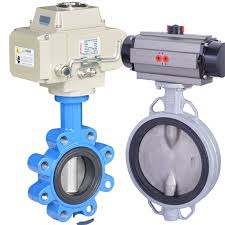
Pneumatic Actuated Butterfly Valve: Smooth Flow Solutions
There are many ways to control and regulate the flow of fluids in a system, but one of the most efficient and reliable methods is through the use of ball valves. Ball valves are essential components in various industries, including chemical, oil and gas, water treatment, and many more. They consist of a spherical disc that rotates inside a housing, allowing or stopping the flow of the fluid. However, not all ball valves are created equal, and mastering flow control requires a deeper understanding of their construction, design, and applications. In this blog post, we will explore the different types of ball valves, their functions, and the benefits of using them.
Types of Ball Valves
Ball valves come in several types, each with its own features and applications. The most common types are:
Full port ball valves: These valves have a larger ball and opening, which allows for maximum flow rate and minimizes pressure drop. They are suitable for applications that require high flow capacity, such as firefighting, industrial water treatment, and irrigation.
Reduced port ball valves: These valves have a smaller ball and opening, which reduces flow capacity and increases pressure drop. However, they also offer better control and accuracy in flow regulation, making them ideal for applications that require precise monitoring and adjustment, such as chemical processing, HVAC, and pharmaceutical production.
Floating ball valves: These valves have a ball that is not fixed to the stem, allowing it to move freely in the housing. They provide a reliable seal and are suitable for low-pressure applications such as domestic water services, compressed air, and gas.
Trunnion ball valves: These valves have additional support at the top and bottom of the ball, which improves their stability and reduces wear and tear. They are commonly used in high-pressure and high-temperature applications such as oil and gas pipelines, power plants, and refining.
Functions of Ball Valves
Ball valves serve a variety of functions in a fluid system, such as:
Isolation: They can completely shut off the flow of fluid in the system, providing a reliable isolation barrier for maintenance, repairs, and safety reasons.
Throttling: They can regulate the flow of fluid by rotating the ball to various degrees of openness or closure, allowing for precise control of the flow rate.
Mixing: They can mix two or more fluids by connecting different ports to different pipes, allowing for customized composition and concentration ratios.
Diverting: They can direct the flow of fluid to multiple outlets or pipelines, allowing for flexibility and adaptability in the system layout.
Benefits of Ball Valves
Ball valves offer several advantages compared to other types of valves, such as:
Low maintenance: Ball valves have few moving parts and are easy to operate, making them low maintenance and cost-effective in the long run.
Durability: Ball valves are made of sturdy materials such as stainless steel, brass, or PVC, which makes them resistant to corrosion, rust, and wear.
Versatility: Ball valves can be used in a wide range of temperatures and pressures, from cryogenic to high-temperature applications, and from low to high-pressure applications.
Tight seal: Ball valves provide a tight seal when closed, preventing leaks and minimizing the risk of contamination or pollution.
Easy automation: Ball valves can be easily automated with an actuator or a motor, allowing for remote operation, monitoring, and feedback.
Tips for Choosing and Using Ball Valves
When choosing and using ball valves, keep in mind the following tips:
Determine the type of ball valve that suits your application, based on the flow rate, pressure, temperature, and material compatibility requirements.
Install the valve in the correct orientation, with the stem pointing upwards and the handle accessible and visible.
Use the right seal material for the fluid you are handling, such as NBR, EPDM, or Viton.
Monitor the valve performance regularly, especially if it is exposed to harsh conditions or frequent usage.
Use a compatible actuator or motor if you want to automate the valve, and test the system thoroughly before putting it into operation.
In short:
Mastering flow control is essential for delivering safe, efficient, and reliable fluid systems. Pneumatic actuated butterfly valve are integral components that enable proper flow regulation and control, and understanding their types, functions, and benefits can help you choose and use them effectively. Whether you need to isolate, throttle, mix, or divert the flow of fluid, a ball valve can provide the right solution. From full port to reduced port, floating to trunnion, ball valves come in various types and sizes to suit your needs. With proper selection, installation, and monitoring, ball valves can provide long-lasting performance, low maintenance, and cost-effective operation. So, if you want to master flow control, start exploring ball valves today!



